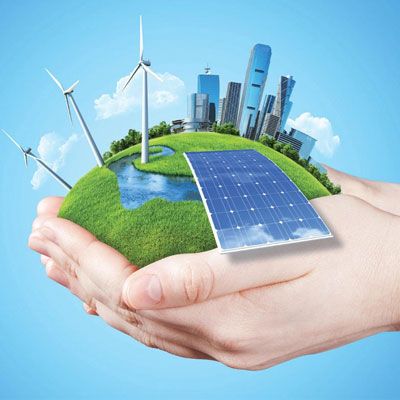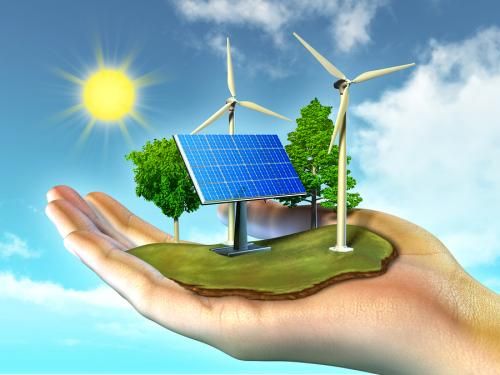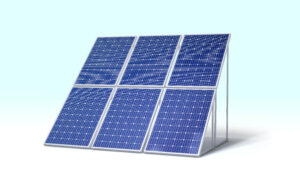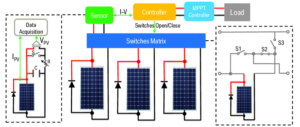SOLAR ENERGY
The main component of a solar panel is a solar cell, which converts the Sun’s energy to usable electrical energy. The most common form of solar panels involve crystalline silicon-type solar cells. These solar cells are formed using layers of elemental silicon and elements such as phosphorus and boron. The elements added to the silicon layers form an n-type layer, which has an excess of electrons, and a p-type layer, which has a deficit of electrons. These two layers form a p–n junction.
When light falls on a solar cell, electrons are excited from a lower-energy ground state, in which they are bound to specific atoms in the solid, to a higher excited state, in which they can move through the solid. In the absence of the junction-forming layers, these free electrons are in random motion, and so there can be no oriented direct current. The addition of junction-forming layers, however, induces a built-in electric field that produces the photovoltaic effect. In effect, the electric field gives a collective motion to the electrons that flow past the electrical contact layers into an external circuit where they can do useful work.
Most solar cells are a few square centimetres in area and protected from the environment by a thin coating of glass or transparent plastic. Because a typical 10 × 10-cm (4 × 4-inch) solar cell generates only about two watts of electrical power (15 to 20 percent of the energy of light incident on their surface), cells are usually combined in series to boost the voltage or in parallel to increase the current. A solar, or photovoltaic, module generally consists of 36 interconnected cells laminated to glass within an aluminum frame. In turn, one or more of these modules may be wired and framed together to form a solar panel.
Solar panels are slightly less efficient at energy conversion per surface area than individual cells, because of inevitable inactive areas in the assembly and cell-to-cell variations in performance. The back of each solar panel is equipped with standardized sockets so that its output can be combined with other solar panels to form a solar array. A complete photovoltaic system may consist of many solar panels, a power system for accommodating different electrical loads, an external circuit, and storage batteries. Photovoltaic systems are broadly classifiable as either stand-alone or grid-connected systems.
Stand-alone systems contain a solar array and a bank of batteries directly wired to an application or load circuit. A battery system is essential to compensate for the absence of any electrical output from the cells at night or in overcast conditions; this adds considerably to the overall cost. Each battery stores direct current (DC) electricity at a fixed voltage determined by the panel specifications, although load requirements may differ. DC-to-DC converters are used to provide the voltage levels demanded by DC loads, and DC-to-AC inverters supply power to alternating current (AC) loads. Stand-alone systems are ideally suited for remote installations where linking to a central power station is prohibitively expensive. Examples include pumping water for feedstock and providing electric power to lighthouses, telecommunications repeater stations, and mountain lodges.
WHAT IS SOLAR POWER?
The sun has been burning and providing heat and light for thousands of years. The ability to harness this energy from the sun to generate heat or electricity basically is solar power.
This form of energy offers numerous benefits when compared to more traditional forms of power.

WHY USE SOLAR POWER?
Unlike traditional energy sources, the sun produces enough energy each second to sustain our power needs for 500,000 years!
The continuous emission of energy isn’t the only positive aspect of incorporating solar power for your requirements.

Why Is Solar Energy Important?
Unlike fossil fuels, which are finite, the sun is a perpetual source of energy. This makes solar power a sustainable and renewable energy source, ensuring that we don’t run out of it in the foreseeable future.
Solar panels produce electricity without emitting greenhouse gases. By transitioning to solar energy, we can significantly reduce our carbon footprint, combatting the adverse effects of climate change.
The cost of solar panels has plummeted over the years, and the significant decrease in upfront costs makes solar power a more accessible option for many. This allows individuals, businesses, and communities worldwide to reap the economic benefits of solar energy, including reductions in electricity bills, low maintenance costs, and participation in programs like net metering and rebates. Moreover, the solar industry has created jobs worldwide, boosting economies and providing employment opportunities.
- Relying on solar energy reduces dependence on foreign oil and imported fossil fuels, fostering energy security for nations. It also allows homeowners and businesses to reduce their reliance on the energy grid.

